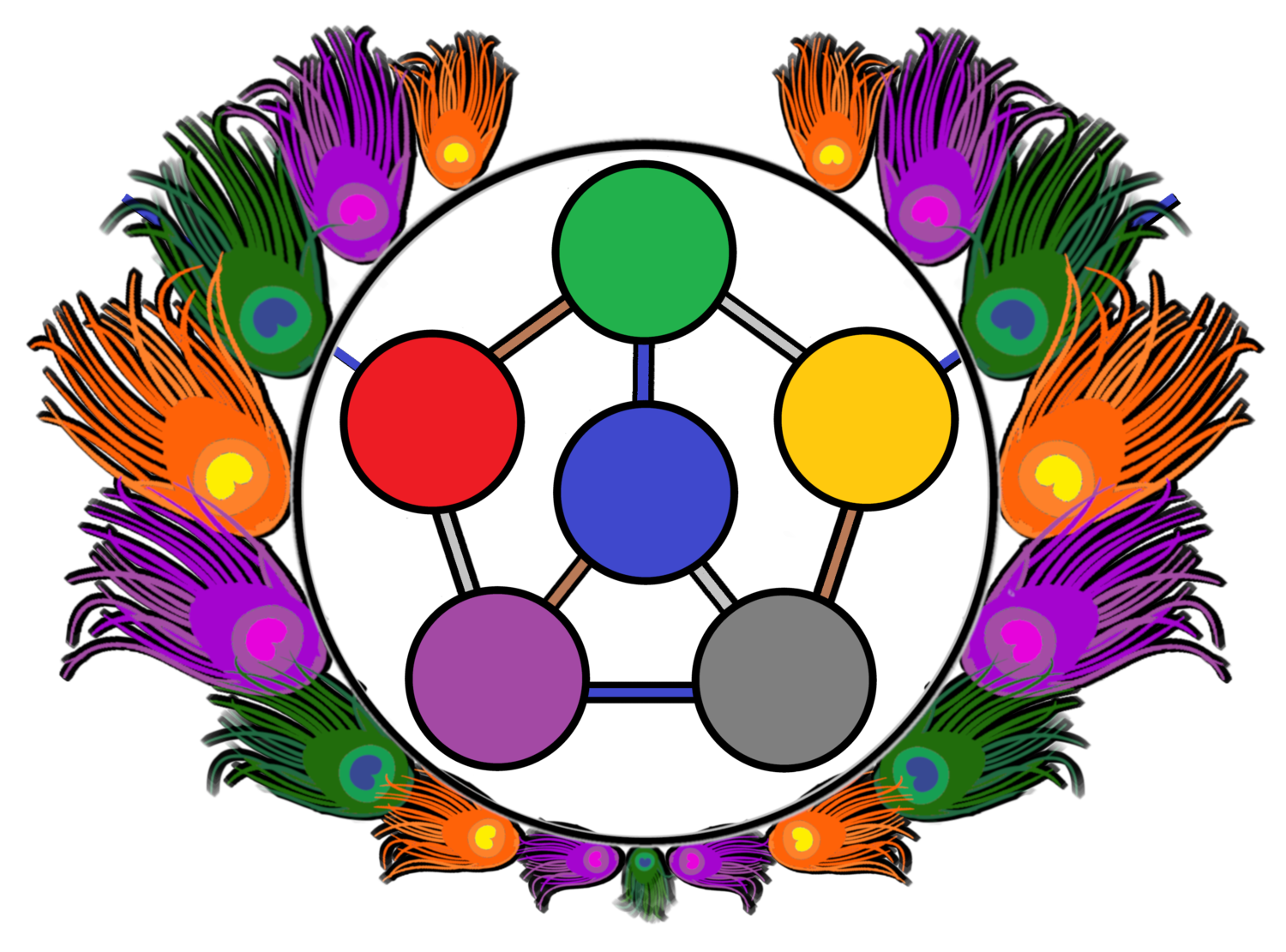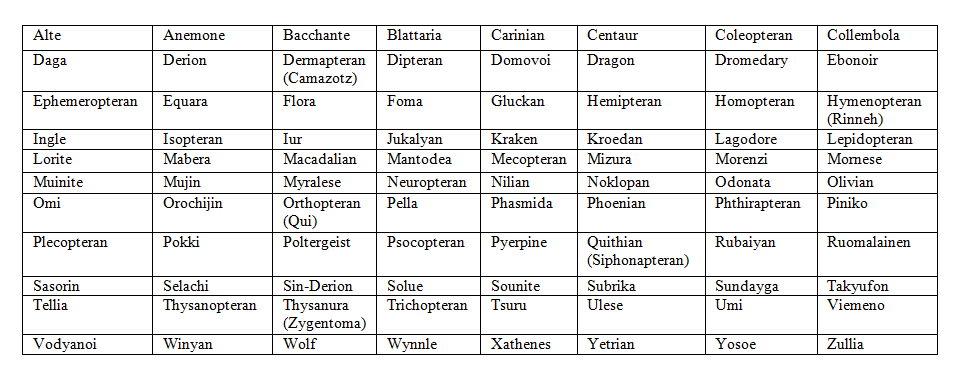The 88 Sapienti Species
Coming Soon
The following pages are works in progress. Eventually I will have information on all 88 of the sapienti species, but it will take a lot of time. I am going in alphabetical order, so at the moment, only a few are complete.
Daga - Ebonoir
Ephemeropteran - Hymenopteran
Ingle - Lepidopteran
Lorite - Mornese
Muinite - Olivian
Omi - Piniko
Plecopteran - Ruomalainen
Sasorin - Takyufon
Tellia - Viemeno
Vodyanoi - Zullia
A note on my invented word ‘sapienti.’ Some might be asking “Erika, why don’t you just call them sapient?” I do, quite often in fact. However, while I was writing my books, I found that ‘sapient’ didn’t always do what I wanted it to do. ‘Sapienti’ is essentially my fantasy-world’s version of the word ‘human.’ If a characters stumbles across the bones of a person, they would refer to the bones as “sapienti bones” meaning “the bones of a sapienti person.” Imagine instead if they’d referred to them as “sapient bones.” That makes it sound like the bones themselves are alive and chatting with you!
So how did a world manage to get eighty-eight different species of people living in it? Time travel.
Many of the sapienti species evolved over billions of years in timelines that the Time Spirit left alone to just let nature take its course. These are usually the more “human-looking” species. Ones with opposable thumbs or which can otherwise use tools.
Some species were made sapient by the blessing of a Mind God. Wynnles came from lions. Yosoe came from goats. All the insect-based species came from, well, insects lol. In the Pentagonal Dominion timeline I write about, there were actually only 87 sapienti species to begin with. The Domovye (singular: Domovoi) were animals. They would be yoked together and trained to dig deep underground, uncovering metals for their sapienti masters. This was seen as no different than yoking oxen to plow a field, or dogs to a sleigh, or a horse to a carriage. The Domovye turned sapient overnight by the blessing of Lucognidus. His purpose in doing so was to punish Ulinor, whose dictator refused to accept the (at the time) new Spiritism religion. Ulinor was the primary civilization that used Domovye as working animals. The Ulese lived underground and needed the Domovye to keep their city functional. But the Ulese abhorred slavery, so when the Domovye became sapient, they could no longer be forced to work.
Many of the species are capable of interbreeding, largely thanks to Life elemental magic. Biologically, without magic, most of them would not work. Their chromosomes would be incompatible or the sperm wouldn’t be able to merge with the egg. Life element magic just “makes it work, damn it.” It will fuck around with genetics until it creates something that can exist. I made this chart a while ago when I was playing a game with some people to create demigods:
It shows how some interbreeding works, but it was within the context of a certain time and place. For instance, the Morenzi can interbreed with any of the others that aren’t in colored boxes, but they currently live in the Quarantined Plane, so none of their hybrids currently exist. It also says Odonata cannot interbreed, but the entire point of Calinthe is that she’s the first and only Odonata hybrid.
The Pentagonal Dominionists use specific language to describe sapienti based on the number of limbs they have. A human might be described as a biped-bibrach (two legged and two armed). A few sapienti look a lot like humans, including the Olivians, Ulese, Umi, Omi, Yetrians, and Myralese. In these cases, the things that make them non-human are deeper than their appearances. Olivians will bond strongly to whoever they first have sex with. Ulese have advanced intelligence. Umi and Omi can control certain internal functions which are automatic and uncontrollable in humans. Yetrians can eat things that a human’s stomach would reject. Myralese are Ice elementals and can survive in frozen environments.
Note that I use ‘nullped’ for species without legs (Domovye, second-stage Orochijin, Poltergeists, Mizura). There is a single monoped species: the Collembola. They have a leg and a tail. They mostly get around by hopping on their tail, but their single leg helps to balance them.
Many of my species are aquatic, too! Or at least can live and breathe underwater if they choose. Aquatic/water-breaking species include: Anemone, Daga, Ephemeropteran, Flora, Foma, Hemipteran, Kraken, Mizura, Phasmida (they can transform into other species, so a Phasmida wouldn’t drown likely because they could transform into someone else), Piniko, Poltergeist, Rubaiyan, Selachi, Sin-Derion, Thysanura, Tsuru, Vodyanoi, Zullia.
Wings are another common feature. Everything that has ‘pteran’ at the end of its name has wings. Other winged species include the Winyans, Pellas, Tsuru, Noklopae, Subrikae, and Nilians.
A few species are extinct in the time period the Merchants novels take place in. The Tellia and Pokki were exterminated by demons when the demons were first created and wanted to take over their homeland. The Mujin went extinct when the Death God Sawyer lost control of his powers in a fit of despair.
A few of these species are also so few in number that a person could go their whole life without meeting one. These include: Odonata, Iur, Mabera, and Phasmida. Technically Phasmida change into other species, so their true numbers are unknown. A Phasmida might live a lifetime in the body of another species and never tell their neighbors that they’re actually a Phasmida. The only one who has made her identity known is Mira, the Chancellor of Aloutia. Because Phasmida only age in the bodies they are currently using, they are effectively immortal. Mira has been the Chancellor since the founding of the Aloutian Empire. She has existed in the Pentagonal Dominion since its beginning. She is actually over 50,000 years old because she’s the Time Spirit’s toy, and she keeps getting put in alternate timelines.
In-world, people might refer to the sapienti species by other numbers. Some will say 87 because they’re excluding the Morenzi, who are unknown to everyone on Aloutia, Cosmo, Ophidia, and the Makai. Some will say 84 because they’re also excluding the three extinct species.
Some species have body parts that naturally produce elementrons, but they can only be used for specific types of ‘magic’ e.g. the Sin-Derion have teeth enchanted to shoot Death elemental beams. Wynnles have electric tails. Yosoe have electric horns. Most winged species have Wind elementrons to allow them to fly because otherwise their bodies would be too heavy/awkward for flight. Daga shells are gold, but enchanted to float on water. Sounites have fire for hair. It’s a whole lotta fun to design all these people!
One thing I want to be clear on, though: no species are monoliths. No species is ‘pure good’ or ‘pure evil.’ They don’t all belong to the same country or culture. They don’t all believe in the same principles, dress the same, speak the same languages, or worship their Gods in the same manner. Sometimes when I talk about my species, I may talk about the culture in which most of them belong. Most Wynnles live on the Wynndalic Plains of Cosmo’s Starsine planet, where they engage in ritual hunting, have strict sexual practices, and speak their own language which few other species speak. But… obvious not all Wynnles are that way. Amiere, Liesle, and their children are Wynnles, but they live on Aloutia, buy their meat at a market or fish it out of Deep Sea, eat a lot of tropical fruits, and speak a sort of pseudo-French patois most commonly spoken by Flora and Ebonoirs. All sapienti have individual, rational minds (some can connect to a ‘hive mind’, but they still retain their individuality, should they choose) and can come to their own conclusions about morality and society.



